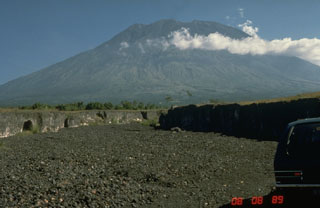Report on Agung (Indonesia) — 27 September-3 October 2017
Smithsonian Institution / US Geological Survey
Weekly Volcanic Activity Report, 27 September-3 October 2017
Managing Editor: Sally Sennert.
Please cite this report as:
Global Volcanism Program, 2017. Report on Agung (Indonesia) (Sennert, S, ed.). Weekly Volcanic Activity Report, 27 September-3 October 2017. Smithsonian Institution and US Geological Survey.
Agung
Indonesia
8.343°S, 115.508°E; summit elev. 2997 m
All times are local (unless otherwise noted)
On 29 September PVMBG reported that earthquakes at Agung were becoming stronger with more felt by local residents, and larger ones felt in areas 45-55 km SW including Denpasar and Kuta. Fumarolic emissions were identified in satellite data, as well as hot areas on the crater floor that had enlarged over the previous week. A new fracture on the crater floor emitted steam. After a M 4.2 earthquake was detected at 1627 on 26 September emissions intensified and rose 500 m above the crater rim. On 4 October BNPB reported that seismicity continued to fluctuate at high levels, and weak emissions rose above the crater rim. The number of evacuees reached 141,213 (spread out in 416 shelters) from 78 villages, though about 2,600 in locations outside of the evacuation zone were returning home; there were 28 villages (about 70,000 people) within the evacuation zone. The Alert Level remained at 4 (the highest level on a scale of 1-4) with the exclusion zone at 9 km, and an additional expansion to 12 km in the SE, S, and SW directions.
Geological Summary. Symmetrical Agung stratovolcano, Bali's highest and most sacred mountain, towers over the eastern end of the island. The volcano, whose name means "Paramount," rises above the SE rim of the Batur caldera, and the northern and southern flanks extend to the coast. The summit area extends 1.5 km E-W, with the high point on the W and a steep-walled 800-m-wide crater on the E. The Pawon cone is located low on the SE flank. Only a few eruptions dating back to the early 19th century have been recorded in historical time. The 1963-64 eruption, one of the largest in the 20th century, produced voluminous ashfall along with devastating pyroclastic flows and lahars that caused extensive damage and many fatalities.
Sources: Pusat Vulkanologi dan Mitigasi Bencana Geologi (PVMBG, also known as CVGHM), Badan Nacional Penanggulangan Bencana (BNPB)

